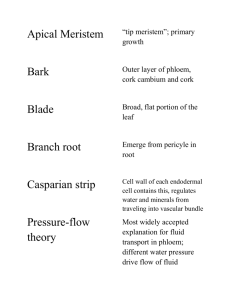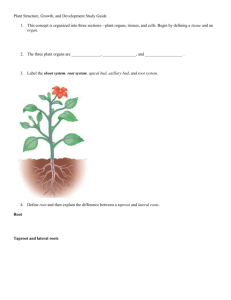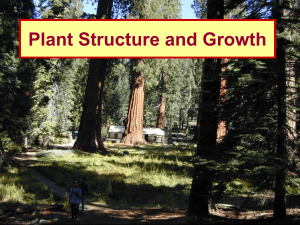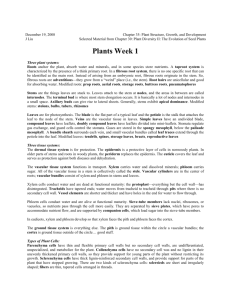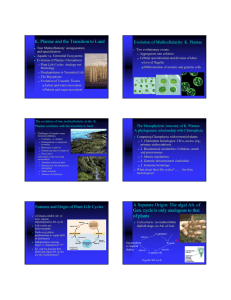Plant Review Notes
advertisement
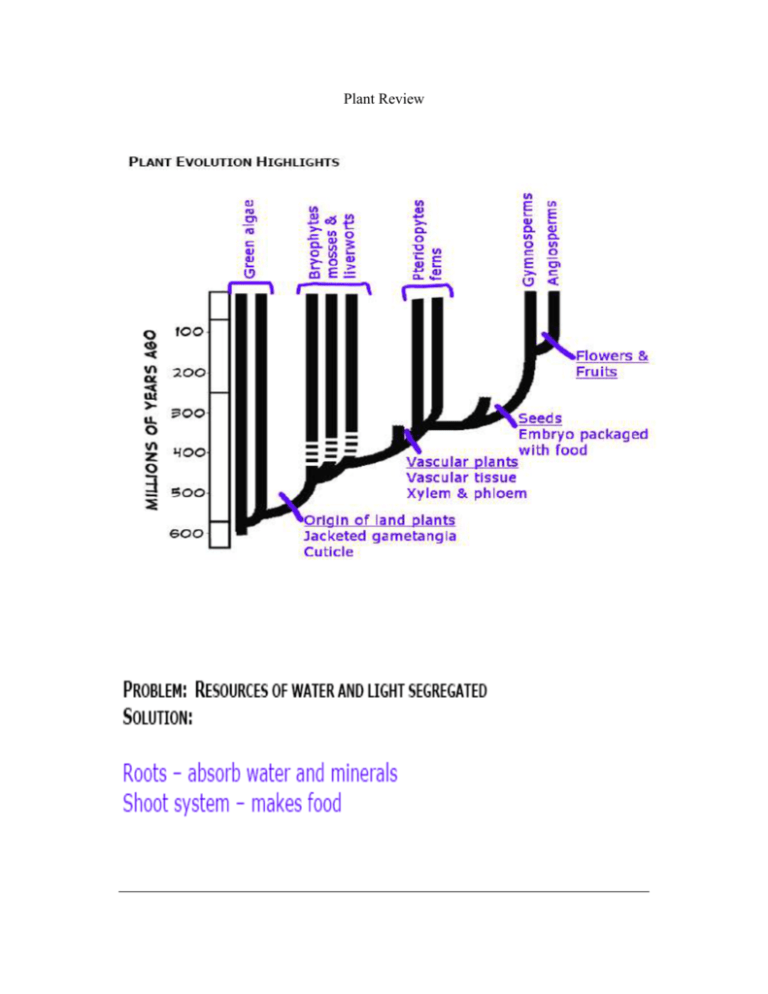
Plant Review Alterations of generation applies to the four main categories of plants I. Bryophytes II. Ferns III. Pine Life Cycle IV. Angiosperms FOCUS ON ANGIOSPERMS Chapter 25 – Plant Morphology (anatomy) and Physiology Chapter 26 – Nutrition and Transport in Plants Chapter 27 – Growth and Control (hormones) Chapter 28 – Reproduction in Plants (flowers and fruits “birds and bees”) Plant Anatomy and Physiology (CH 25) Focus will be on the most modern of plants the Angiosperms. Basic Morphology Plant Cells, Tissues, Organs and Organ System Plant and animals have a hierarchy of cellular architecture At the lowest level are cells o Example: Parenchyma, Sclerenchyma, vessel elements Cells are organized together to form tissues o Example: xylem, phloem Tissues are organized together to form organs (two or more tissues performing specific functions) o Example: Leaves, stamens Organs are organized together to form organ systems o Example: Flowers, shoots Cell Types in the Plant Body Parenchyma Cells Least specialized plant cells Thin and somewhat flexible cell walls Living at maturity Carry on most of the plant's metabolic functions Generally have a large central vacuole Most parenchyma cells have the ability to differentiate into other cell types under special conditions o During repair and replacement of organs after injury Collenchyma Cells Thicker primary cells walls (usually with uneven thickness) Living at maturity Role in support of herbaceous plants o Example - the "strings" of celery Sclerenchyma Cells Thick secondary cell walls Dead at functional maturity Cannot increase in length - occur in parts of the plant which have quit growing in length Two types - fibers and schlerids o Fibers - long, slender cells with a more or less regular secondary cell wall Example - hemp fibers for making rope o Sclerids - shorter cells with an irregular shape Example - stone cells in pears and hard nut and seed shells Some Tissues in the Plant Body Xylem Involved in conduct of water and ions in the plant Typically composed of non-living conductive cells and living parenchyma cells o Conductive cells have thick secondary cell walls, often deposited unevenly in a coil-like pattern so that they may stretch o Dead at functional maturity o Two types of conductive cells- tracheids and vessels Tracheids - long, slender cells connected to each other by pits. Found in all vascular plants Vessels - shorter, larger diameter cells with completely perforated cell wall ends. Found only in Angiosperms Xylem Parenchyma arranged in rays Xylem parenchyma are also distributed throughout the tracheids and vessel elements Phloem Involved in transport of sucrose, other organic compounds, and some ions Conductive cells living at functional maturity o Protoplast may lack organelles and nucleus, though Endwalls connect to each other via sieve-plates Two types of conductive cells in the phloem - sieve-tube members and companion cells o Sieve-tube members - actual conduit for sucrose transport o Companion cells - has a nucleus that may also control the sieve-tube element and may aid in sucrose loading Sclerenchyma tissue is often associated with phloem Dermal Tissue Generally a single layer of cells The "skin" of the plant Primarily parenchyma cells Main role is protection of the plant Ground Tissue Makes up the bulk of the plant Predominately parenchyma, but collenchyma and schlerenchyma cells are found Diverse functions including photosynthesis, storage, and support Pretty much, if you look at something and it isn't dermal tissue nor is it vascular tissue, it is ground tissue Plant Growth Plant growth is a phenomenon different from animal growth. Animas exhibit a growth pattern called determinate growth. After fertilization, the zygote cells are rapidly dividing, undifferentiated cells However, after a certain critical stage, the cells differentiate and form tissues. o From this point onward, their developmental fate is sealed o There are exceptions to this (i.e. stem cells in bone marrow) Most animals have a pre-programmed body plan (i.e. barring mutation or accident, most humans have 10 fingers and toes, two eyes, a heart with four chambers, etc..) Most animals quit growing after a certain age Plants, however, exhibit a growth pattern called indeterminate growth The plant retains areas where rapidly dividing, undifferentiated cells remain all through the life of the plant These areas are called meristems o Meristematic tissue continues to rapidly divide producing undifferentiated cells which may eventually differentiate to form the tissue and cell types discussed above Plants do not have a pre-programmed body plan o There are constants like leaf shape and branching patters (opposite, alternate, etc.) but you can never predict where a new branch will come about on a tree... Plants continue to grow throughout their life Meristems The pattern of plant growth depends upon the location of meristems Apical meristems located at the tips of roots and shoots supply cells for the plant to increase in length (grow up for shoots and down for roots) o growth in this direction is known as primary growth o primary growth found in herbaceous and woody plants o primary growth found in monocots and dicots Lateral meristems located near the periphery of the plant, usually in a cylinder supply cells for the plant to increase in girth o growth in this direction is known as secondary growth o found in all woody and some herbaceous plants o lateral meristems and secondary growth found only in dicots Primary Growth in the Root Root Cap o Thimble-like covering which protects the delicate apical meristem o Produced from cells derived from the root apical meristem o Secretes polysaccharide slime that lubricates the soil o Constantly sloughed off and replaced Apical Meristem o Region of rapid cell division of undifferentiated cells o Most cell division is directed away from the root cap Quiescent Center o Populations of cells in apical meristem which reproduce much more slowly than other meristematic cells o Resistant to radiation and chemical damage o Possibly a reserve which can be called into action if the apical meristem becomes damaged The Zone of Cell Division - Primary Meristems o Three areas just above the apical meristem that continue to divide for some time o Protoderm - outermost primary meristem - produces cells which will become dermal tissue o Ground meristem - central primary meristem - produces cells which will become ground tissue o Procambium - innermost primary meristem - produces cells which will become vascular tissue The Zone of Elongation o Cells elongate up to ten times their original length o This growth pushes the root further downward into the soil The Zone of Maturation o Region of the root where completely functional cells are found Root Anatomy - Dicot Roots Epidermis Dermal tissue Protection of the root Cortex Ground tissue Storage of photosynthetic products Active in the uptake of water and minerals Endodermis cylinder once cell thick that forms a boundary between the cortex and the stele contains the casparian strip, which will be explained later when we discuss water uptake Pericycle found just inside of the endodermis may become meristematic responsible for the formation of lateral roots Vascular Tissue Xylem and Phloem Forms an X-shaped pattern in very center of root Root Anatomy - Monocot Roots Epidermis Dermal tissue Protection of the root Cortex Ground tissue Storage of photosynthetic products Active in the uptake of water and minerals Endodermis cylinder once cell thick that forms a boundary between the cortex and the stele even more distinct than dicot counterpart contains the casparian strip, which will be explained later when we discuss water uptake Pericycle monocot roots rarely branch, but can, and this branch will originate from the pericycle Vascular Tissue Xylem and Phloem Forms a ring near center of plant Pith Center most region of root Primary Growth of Shoots Apical Meristem Dome-shaped mass of dividing cells at tip of terminal bud Gives rise to three primary mersitems: protoderm, ground meristem, and procambium just as root apical meristem Leaves arise as leaf primordia on the flanks of apical meristem Axillary Meristems Regions of meristematic tissue left behind from apical meristem Dormant, but have the ability to become activated and form a branch (i.e. becomes the branch's apical meristem) o Note difference between how shoots forms a branch versus how a root forms a branch o This is do to the position of the vascular tissue in a root vs. the vascular tissue in a shoot Subtended by a leaf Secondary Growth Lateral Meristems add girth by producing secondary vascular tissue and periderm Secondary Plant Body - tissue produced mersitems involved in secondary growth Vascular Cambium - secondary growth meristem which produces xylem and phloem Cork Cambium - secondary growth meristem which produces cork, a tough substance that replaces the epidermis Vascular Cambium Secondary growth begins with the initiation of the vascular cambium, a cylinder of meristematic tissue that produces additional xylic and phloic tissues. The cells that eventually form the vascular cambium come from two sources, the procambium in the vascular bundles and the interfascicular parenchyma cells between vascular bundles. The diagram below shows the positions of these two populations of cells in a stem with only primary growth. The two populations of dividing cells unite to form a continuous ring of dividing cells, the vascular cambium. If we look closely at the cells of the vascular cambium we see two patterns of division. Initial cells can undergo multiplicative divisions (red line in the following diagram) or they can undergo additive divisions (blue line). Multiplicative divisions produce more initial cells and result in the increased circumference of the vascular cambium. Of the two cells produced from an additive division one is retained as an initial cell that will divide again, and the other will become a phloem mother cell or a xylem mother cell. These mother cells will differentiate into their respective cell types. Secondary Growth in Dicots - Herbaceous and Woody Both herbaceous and woody dicots exhibit secondary growth. In herbaceous dicots, secondary xylem and phloem are in a single ring of discrete bundles which form In woody dicots, the secondary xylem forms a continuous cylinder The Cork Cambium and the Production of Periderm During secondary growth, the epidermis produced by primary growth splits and falls off the stem It is replaced by a new protective tissues produced by the cork cambium A cylinder meristematic tissue that initially forms from the outer cortex of the stem Cork cambium produces cork cells, which form exterior to the cork cambium As cork cells mature, they secrete suberin (a waxy substance) in their cell walls and then die Cork cells function as a barrier to protect the stem from physical damage and from pathogens The cork cambium + the cork are known as the periderm The "bark" of the tree consists of the periderm + the phloem What would happen if you removed a large ring of bark from a tree? Unlike the vascular cambium which can grow in diameter via multiplicative growth, the cork cambium is fixed in size. After a few weeks, the cork cambium loses meristematic ability Expansion splits the original periderm New cork cambium then forms deeper in the cortex of the stem Eventually no more cortex remains, so the cork cambium then forms from parenchyma cells of the secondary xylem The Monocot Stem - A Stem Lacking Secondary Growth Monocot stems differ from dicot stems in that they lack secondary growth No vascular cambium nor cork cambium Stems usually uniform in diameter Scattered vascular bundles (not in a ring like dicot stems) Transport in Plants Transport in plants occurs on three levels: the uptake and release of water and solutes by individual cells o absorption of water and minerals from he soil by root cells short-distance transport of substances from cell to cell o loading of sucrose from photosynthetic cells into the sieve tube cells of the phloem long-distance transport of sap within the xylem and phloem o this is a whole plant phenomena - transport of photosynthate from leaf to root Cellular-level Transport A key component of cellular-level transport is the movement of solutes and ions across the plasma membrane. We have already covered this, so I won't repeat it. If you are unsure, review Lecture 9. Survival of the plant depends on balancing water uptake and water loss. In an animal cell, water flows from hypotonic to hypertonic solutions, but in a plant cell, there is the added presence of the pressure created by the cell wall The combination of solute concentration differences and physical pressure are incorporated into water potential, abbreviated with the Greek letter psi ( ) Water will flow through a membrane from a solution of high water potential to a solution of low water potential Water potential is measured in units of megapascals (MPa) Pure water has a water potential of 0 MPa ( = 0 MPa) o The addition of solutes lowers water potential ( = -0.2 MPa for instance) o An increase in pressure (by lowering a piston for example) will raise water potential These two forces combine to form the following equation: o = p+ s o = total water potential o p = water potential due to pressure May be positive or negative o s = water potential due solute concentration (also known as Osmotic Potential) Always negative or zero Movement of Water Through Cells - Two Routes, the Symplast and the Apoplast Symplastic Movement Movement of water and solutes through the continuous connection of cytoplasm (though plasmodesmata) No crossing of the plasma membrane (once it is in the symplast - however, if the solute was initially external to the cell, then it must have crossed one plasma membrane to enter the symplast) Apoplastic Movement Movement of water and solutes through the cell walls and the intercellular spaces No crossing of the plasma membrane More rapid - less resistance to the flow of water Absorption of Water and Minerals by Roots Absorption is a surface area phenomenon - the more surface area there is, the more absorption there will be. Root hairs - extensions of the root epidermal cells to increase surface area Mycorrhizae - fungal associations with roots - greatly increase surface area o as much as three meters of fungal hyphae can extend from each centimeter of root o this is an ancient association - some of the oldest terrestrial plant fossils have fungal associations o click here to download a pdf of a paper on this if you're interested (its on page 6) As water is drawn into the root, dissolved minerals are also brought into the root Water flows through the apoplast and the symplast on its way to the xylem o The majority of the water, however, travels through the apoplast The Endodermis - The Root's Border Guard Water flowing through the apoplast contains many minerals that the plant needs - it may also contains toxins and substances that the plant may not want. However, since the water is flowing through the apoplast, there is no way to prevent the passive transport of these toxins, until the water hits the endodermis. Endodermis Cells of the endodermis possess cell walls that are ringed by the Casparian Strip, a waxy layer (composed of suberin). The Casparian Strip is a wax and therefore prevents the apoplastic flow of water Water must pass through the plasma membrane and enter the symplast The plasma membrane of the endodermal cells contain many transport proteins to actively transport some molecules in and others to pump other molecules out Once water passes under the Casparian Strip in the endodermal cells, it is free to enter the apoplast again on its way to the xylem. Transport of Xylem Sap Xylem sap rises against gravity, without the help of any mechanical pump, to reach heights of more than 100m in the tallest trees. How can this occur? Transpiration-Cohesion-Tension: A Mechanism to Pull Xylem Sap up the Plant Stomata open up during the day to let CO2 in and inadvertently let H2O escape There is a gradient in water potential, high water potential in the soil and very low water potential in the air Water vapor leaves the air spaces of the plant via the stomates This water is replaced by evaporation of the thin layer of water that clings to the mesophyll cells Remember, water has strong adhesive and cohesive properties - as the water leaves, it is replaced by water clinging to the inside of the cell walls o This creates a tension (pulling) on the water in the xylem and gently pulls the water toward the direction of water loss o The cohesion of water is strong enough to transmit this pulling force all the way down to the roots o Adhesion of water to the cell wall also aids in resisting gravity As we said before, the water column in the tallest trees can be 100m - the tension created by evaporation of water coupled with the cohesive and adhesive forces is enough to support this column against the forces of gravity Root Pressure: A Mechanism to "Push" Xylem Sap Up the Plant At night, transpiration is almost nil. However, the root cells continue to actively transport minerals into the stele (the root stele is basically everything surrounded by the endodermis - primarily the xylem and the phloem). This active transport lowers the water potential within the stele Water passively flows into the roots, pushing the water up against gravity Water that reaches the leaves is often forced out, causing a beading of water upon the leaf tips known as guttation In most plants, however, root pressure is not the primary mechanism for transporting the xylem o Tall trees generate almost no root pressure (the weight of the water pushing down on the xylem more than counteracts any generated root pressure) The Control of Transpiration Water is needed for photosynthesis - it is also lost as a product of obtaining carbon by this very same process. How does the plant balance is requirement for water with its requirement for carbon in photosynthesis? Guard cells control the size of the stomatal openings and thus regulate gas and water exchange Water loss by a plant through stomatal openings is known as transpiration The efficiency of a plant can be measured by its transpiration-to-photosyntesis ratio o The amount of water lost per gram of CO2 assimilated into organic material created by photosynthesis o A typical ratio for a C3 plant is 600:1 - for a typical C4 plant it is more like 300:1 As long as plants can pull water from the soil as fast as it leaves from the leaves, there is no problem When water loss exceeds water uptake, the plants will wilt as the leaves lose turgor pressure o The conditions that favor wilting are hot, sunny, and windy days How Stomates Open and Close Each stoma is flanked by a pair of guard cells that are capable of changing shape, thereby widening or narrowing the gap between the two cells When dicot guard cells take in water by osmosis, they become turgid and swell o Guard cells are not uniformly thick - this, along with a series of radically oriented cellulose microfibrils in the cell wall, cause the guard cell to buckle outwards. As they swell, the gap between the guard cells widens If the plant loses water, the guard cells become flaccid and the gap closes The changes in turgor pressure result primarily through the reversible uptake of K+ ions Stomata open when guard cells accumulate K+ from neighboring epidermal cells o How does this change the water potential ( ) in the guard cells? Stomata close when K+ leaves the guard cells into the neighboring epidermal cells o The transport of K+ is probably coupled to the transport of H+ in an antiport system (see Fig 36.2) Stomatal opening is triggered by light o Blue light receptors are present on the membranes of guard cells o Stimulation of the blue-light receptors stimulates an ATP-poweed proton pump on the plasma membrane o The pumping of H+ out of the cell creates and electrical potential which drives in cations like K+ Plants also observe a 24 hour cycle (a circadian rhythm) o If placed in total darkness, the plant will still open its stomates when it normally would if there was light Adaptations to reduce transpiration loss in plants growing in dry conditions (xerophytes) Thick cuticles - prevent water loss from epidermal cells Succulent (thick) leaves - store water Loss of leaves/reduction of leaves to form spines - light is not limiting, so photosynthesis can be carried out by the shoot o What type of plant am I describing? White leaves/spines - light colors reflect light and heat, thereby cooling the plant Trichomes (hairs) - create a more humid microenvironment to reduce evaporative water loss Sunken stomates - like trichomes, a more humid microenvironment is created CAM photosynthesis - stomates open during the night (when it is cooler) and fix CO2 into four-carbon acids o The light reaction occurs during the day, generating NADPH and ATP The Translocation of Phloem Translocation - the process of moving photosynthetic product through the phloem In angiosperms, the specialized cells that transport food in the plant are called sieve-tube members, arranged end to end to form large sieve tubes Phloem sap is very different from xylem sap o sugar (sucrose) can be concentrated up to 30% by weight Phloem transport is bidirectional o Phloem moves from a sugar source (a place where sugar is produce by photosynthesis or by the breakdown of sugars) to a sugar sink (an organ which consumes or stores sugar) o What are some organs which would be sugar sinks? Phloem Loading and Unloading Sucrose manufactured in the mesophyll cells can travel via the symplast to sievetube members In some species, sugar can leave the symplast and enter the apoplast, where is it pumped back into the sieve-tube members and the companion cells o Some companion cells have cell wall ingrowths that facilitate apoplatic transport of sucrose into the symplast Sucrose is loaded into the phloem via a chemiosmotic ATPase mechanism coupled with a H+/sucrose symport (taken from Lecture 8 notes) Other Active and Transport Mechanisms - The H+ / Sucrose Pump o H+ is actively pumped out by hydrolyzing ATP o H+ accumulated outside the membrane, generating a concentration and electrochemical gradient o The H+ cannot cross the membrane, but there is a carrier protein o H+ binds to carrier protein, but sucrose must also bind. When both are bound, the configuration changes and the protein opens to the membrane interior. o Downstream, sucrose must be unloaded, again utilizing an H+ / Sucrose pump The Mechanism of Translocation in Angiosperms Phloem loading results in a high solute concentration at the source end of the o This creates hypnotic conditions in the phloem, causing water to flow into the phloem o Hydrostatic pressure builds in the sieve tube, but it is greatest in the source At the sink, osmosis occurs with the unloading of sugar - water flows out of the phloem The buildup of pressure at the source and the reduction of that pressure at the sink causes water to flow from source to sink, carrying the sugar along with it. o Water is recycled via transport in the xylem This explanation is very simplified - scientists are just now discovering the subtle details of phloem movement in plants PLANT HORMONES Auxin – IAA Promotes elongation of developing cells Produced in apical meristems Responsible for phototropism and gravitropism – know the process and the experiment that demonstrated this Cytokinins Stimulates cell division Produced in roots and transported in xylem Weakens apical dominance and promotes lateral buds Delays aging of leaves by inhibiting protein breakdown, stimulates RNA and protein synthesis, increases nutrients Gibberellins Promotes cell growth in leaves and stems Produced in young leaves, roots and seed germination, Breaks seed germination – know process!! High concentration causes bolting and flowering Abscisic acid Growth inhibiter Produced in terminal bud and helps plant prepare for winter by suspending growth Produces dormancy in seeds Closes stomata in times of water stress Etlylene A gaseous hormone Promotes ripening of fruit, production of flowers Inhibits elongation of roots, stems and leave and influences leaf abscission (aging and falling of leaves) Tropisms: know the difference between a positive and negative tropism response for each Phototropism – growing in response to light Gravitropism – growing in response to gravity Thigmotropism – growing in response to touch Photoperiodism – physiological response due to amount of light exposure, influences flowering and growth
